Three’s Not Always a Crowd…
Let’s Talk Three Stone Engagement Rings!
Aren’t sayings funny? We throw them around so often, but rarely take the time to think about them. Once my Grandpa described someone as ‘all hat and no cattle’ and I thought it was the funniest thing I had ever heard. I was five, but whatever. Some are very accurate indeed, like ‘opposites attract’ (magnets, and also me/husband), while others leave a lot to be desired such as ‘the best things in life are free’…. Em, diamonds ain’t free,?! Others still, need a bit of rejigging. For example, whomever coined the term “two’s company, three’s a crowd” obviously has never had the pleasure of a three stone diamond ring perched delicately on their ring finger, amiriiiight? I mean, think about it, people; what could be better than one diamond? THREE DIAMONDS. That’s what’s better. In my humble opinion we need to take a page out of Andrea True Connection’s book when asked ‘how many diamonds would you like?’, and respond with a firm MORE MORE MORE!
Now, if you cannot guess what a diamond three-stone engagement ring is, you’re in trouble mate. Clue’s in the name really isn’t it? Yup, a three stone engagement ring is simply an engagement ring that features… three stones. So instead of one single diamond in the center of the ring (still stunning), you will have three main stones (like a diamond encrusted slap in the face). Sometimes these three diamonds are all the same size, like this bad boy:

I’d Steal This Off Your Finger Without a Second Thought
While some three stone rings will play with sizes by keeping the two outside stones slightly (or significantly) smaller than the center stone, like this little darling right here:
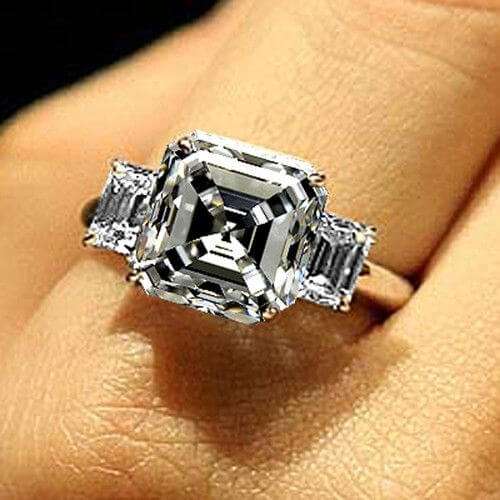
I Would Do Morally Ambiguous Things for This Ring
Now, these two side stones are not to be confused with channel-set diamonds (diamonds set into the band of the ring itself), because you can actually have a three stone diamond engagement ring in a channel setting, just like you can have a three stone ring with a pavé setting too, like these two beauties:
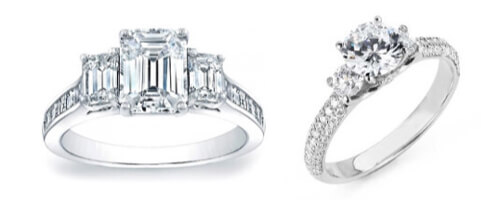
The Epitome of More, More, More!
These three stone rings (or trilogy rings) are not just diamond-encrusted-slap-in-the-face gorgeous however. They have the added bonus of having a really beautiful meaning behind them. Intrigued? Let me explain…
You know that super corny moment in rom-coms where the ‘com’ turns positively ‘rom’ (i.e. mushy AF), and you are sitting with your friend trying to pretend like you think it’s corny and silly but secretly you are melting inside, swaying in your seat and singing ‘The Greatest Love of All’ in your head? No? Just me? OK, this is awkward.
Anywho, the meaning behind the three-stone/trilogy ring is kinda like the above moment that absolutely none of you have ever had, nope, no way (*cough*). You see, each of the three stones has a symbolic meaning; one represents the past you both have shared together, another the present that you are living in, and the final one is the future ahead of you…. I’M NOT CRYING, YOU'RE CRYING!
*singing* “I BE-LIEVE THAT CHILDREN ARE OUR FU-TURE….”
Let’s quickly run through the main pros (of which there are many) and cons (of which there are few) of these three stone diamond engagement rings.
Pros of Three Stone Diamond Engagement Rings:
For me, one of the biggest pros of a three stone ring is the crazy amount of versatility the style provides. Honestly, the only thing limiting you here (other than that horrid thing called ‘budget’) is your imagination. The possibilities for customization are endless! As we saw above, you can have three equal sized diamonds, or indeed a larger stone flanked by two smaller diamonds on either side. This particular style is super popular, again because the symbolism of the larger central stone representing the current moment in your lives is just so darn sweet.

Almost as Sweet as This Bunny
Whether you go with three equally sized diamonds or not is completely a matter of preference and personal style. Some peeps live for three equal sized rocks, while others love the center/two smaller stones vibe. It’s totally up to you and we support your decision 1000000% no matter what you like. If you do want to have the ‘center stone/two smaller side stones’ look however, it’s advised that you should aim for two side stones that are approximately one third the size of your center stone. The last thing you need is for the difference in size between all three stones to be so slight that they look mismatched rather than deliberately different sizes. This will still give you the gorgeous three stone look, while making that center stone really pop! If you are unsure about sizes/ratios, follow this little cheat sheet to get a sense of the perfect diamond ratios for you…
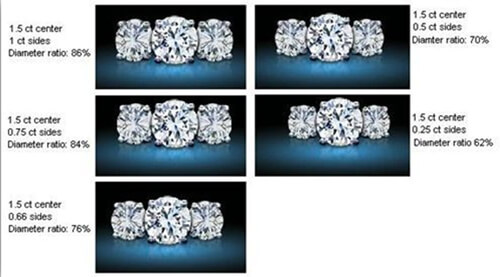
But wait! It’s not just size that you can play around with and customize to your little hearts content! You can play with stone shapes too. In a world with too many rules (JK we love rules), there are really no rules when it comes to mixing and matching diamond shapes with this style of setting. You could have three round cut diamonds, three emerald cut diamonds, princess cut diamonds, cushion cut etc., etc. – you get the picture. All are fabulous, and all will look stunning.

You, to Your Engagement Ring
Now you know that at Rare Carat we’re all about dem diamonds, but we do know a gorgeous non-diamond stone when we see one. Sometimes it just makes sense for some brides/grooms to add other precious stones/semi-precious stones/birthstones to their engagement rings - and three stone rings offer the perfect opportunity to do just that. Are you a sucker for a blue sapphire? Do you go green with envy at the sight of an emerald? Are you open to opals? (I should stop doing these now, shouldn’t I). Whatever your preference, we say add those babies in if that’s your jam. You could go for a poppin’ center diamond with a couple of snazzy side stones like this:
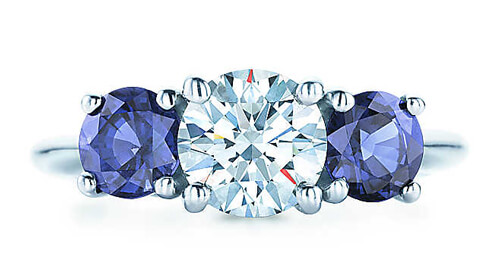
Setting My Soul on Sapphire... GET IT?!
If the idea of a side-stone morganite/emerald/ruby/sapphire engagement ring doesn’t float your boat, you could let that non-diamond stone take center stage by having diamonds as the side stones, just like this tasty little snack right here:

LIVING For Those Yellow Gold/White Gold Prongs!!!
But hold your horses, guys and gals. Did you think that’s as awesome as three stones get? Think again my internet friends! Yet another major upside to the three stone is the fact that you will not need to sell a kidney to pay for it. You see, a three stone diamond ring can often be far more affordable than one large single diamond. Smaller diamonds are always going to be cheaper than a single diamond of the same carat weight, because diamond prices increase exponentially with the increase in weight. Three .33 carat diamonds will cost much less than one 1 carat diamond for example.
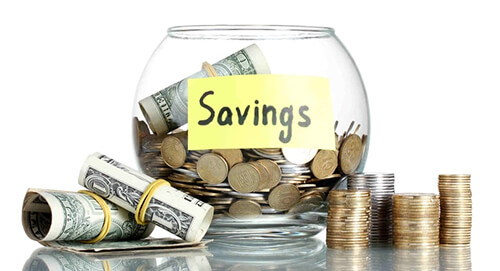
Saving Dat Cash with a Three Stone Ring
Side note; if saving even more cash sounds like something you and your better half might be interested in, why not be a little bit more flexible on the metal type you choose? We are not saying that you should set your ring in sterling silver, but it might be an idea to go with a lower purity of gold for the ring itself. For instance, going for a 14k white gold/14k rose gold/14k yellow gold instead of the 18k version, will certainly save you some money, without negatively impacting the look of the gold or the hardness of the ring! In fact, lower purity gold is actually harder than it’s higher, fancier cousins. Remember this little hot tip when you are choosing the type of metal for your band, folks!!
Cons of Three Stone Diamond Engagement Rings:
I’m pretty much racking my brains trying to find any downsides of a three stone ring. If I was pushed to say something negative (and I mean reeeeally pushed), I would say that a three stone ring does require a little bit more maintenance than a single stone ring, simply because there are more nooks and crannies for dirt to get inside (especially from underneath the setting itself), while also having more prongs to worry about (thus more opportunities for one of those rascals to loosen or break leaving you crying. In terms of keeping it clean, just make sure you have an old soft-bristled toothbrush on hand to give it a gentle scrub once in a while. You will need to be especially gentle if you do have non-diamond stones in that ring (emeralds/rubies/sapphires etc.) as they are much easier to scratch than diamonds.
Finally – and this is more of a tip than a criticism – do make sure that you choose your three stones wisely. There is no point in having a stunning center diamond if you decide to pair it with two diamonds (or non-diamonds) of shocking quality. Now, if you plan on having a larger center stone with two smaller side stones, it’s perfectly acceptable to slip down a color/clarity grade for those smaller stones while investing in the better quality for your main diamond. We are 100% behind you in this, and almost every other choice you make. If you want three stones of equal size, then we suggest making sure they are all of similar in terms of color/clarity/cut grade. You don’t want two nasty side stones distracting from the main event, do you?
Three Stone Engagement Rings

